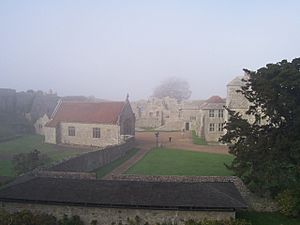Jane Whorwood facts for kids
Jane Whorwood (born Ryder; 1612 – September 1684) was a brave Royalist agent during the English Civil War. She helped the King's side by secretly sharing information and moving money. Jane Whorwood was a very trusted friend of King Charles I. She even helped him try to escape when he was held captive in the late 1640s.
Contents
Early Life and Family
Jane was born in Westminster in 1612. Her father, William Ryder, managed the royal stables. Her mother, Elizabeth de Boussy, was a laundress for Anne of Denmark, who was the wife of King James I.
After her father passed away, her mother married again in 1619. Her new husband was James Maxwell, an important person at the King's court.
In 1634, Jane married Brome Whorwood. When the Civil War started in 1642, her husband left England for Europe. Jane and their children, Brome and Diana, stayed at their family home, Holton House, near Oxford. Oxford was where the King's court was based during the war. But Jane Whorwood traveled a lot as an active Royalist agent.
Helping the King During the Civil War
Jane's stepfather and mother had many contacts, including merchants and laundresses. These connections helped Jane support the Royalist cause. Her stepfather, James Maxwell, had important roles at court for both Prince Henry and King Charles. He also lent money to King Charles I. This helped him work with merchants who later helped Jane secretly move money for the Royalists during the war.
Once, with the help of a laundress, Jane Whorwood secretly moved a huge amount of gold. It was about 1,705 pounds (775 kg) of gold! The money came from a Royalist merchant named Paul Pindar in London. It was delivered to Oxford hidden inside barrels of soap.
Jane Whorwood was a strong supporter of King Charles I throughout the 1640s. She worked to gather more money and created a network of Royalist contacts. This network stretched from London all the way to Edinburgh. She also secretly sent information to and from the King and his supporters.
She was also involved in helping King Charles I try to escape. In 1647, she asked a famous astrologer, William Lilly, for advice. This was about the King's plan to escape Hampton Court, where Parliament was holding him. In 1648, Lilly also helped her find a locksmith. From this locksmith, she got tools to help the King escape from his room at Carisbrooke Castle, on the Isle of Wight.
However, the King's escape attempt was not successful. Jane Whorwood waited for weeks on a ship she had helped get. She hoped to sail the King to Holland, but he never made it.
What Jane Whorwood Looked Like
We don't have any pictures of Jane Whorwood. But a spy for Parliament, Anthony Wood, described her in 1648. He said she was "a tall, well-fashioned and well-languaged gentlewoman, with a round visage and with pock holes in her face."
Years later, he added more details. He said she had "red hair" and was "exceedingly loyal, understanding and of good judgement." He also said she was "the most loyal to King Charles in his miseries of any woman in England."
Her Close Bond with the King
Secret letters between King Charles I and Jane Whorwood show how close they were. They wrote to each other often, sometimes many times a day. The King wrote about her in 1648: "You may freely trust Whorwood in anything that concerns my service, for I have had perfect trial of her friendship to me. I cannot be more confident of any." Between April and December 1648, the King wrote 33 letters to her, and she sent 18 to him.
Even with all the efforts of his supporters, King Charles I was put on trial and executed. This happened at Whitehall Palace in London on January 30, 1649.
Life After the War
In 1651, Jane Whorwood was briefly put in prison herself. This was during the time of the Commonwealth. She also had to pay a fine for trying to get money for the Royalists.
That same year, Jane returned home to her husband, Brome. He became very difficult and kept her confined in the tower of Holton House for a while. In 1657, Jane left home for good because she was worried for her safety. Sadly, their son died that same year while sailing to the Isle of Wight.
After they formally separated in 1659, Jane and Brome had a long legal fight over money. Brome became a Member of Parliament in 1661, after King Charles II returned to the throne. But he refused to give Jane the money she was legally supposed to get. This left her very poor. People from Holton spoke up for Jane in court many times. They told the court about the difficult times she had with her husband.
Brome died in April 1684, and Jane Whorwood died in September of the same year, at age 72. Jane Whorwood once wrote about her efforts to help the Royalists: "My travels, the variety of accidents (and especially dangers) more become a Romance than a letter." She felt her story was like an adventure novel.


